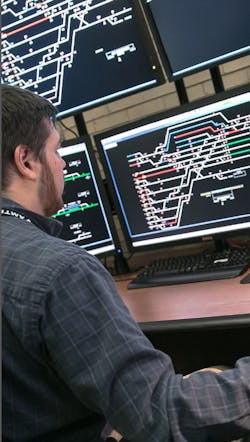By ED SULLIVAN -- Over the last few years Amtrak has been busy working on more than just the railroad. In a move to transport America’s passenger rail system into the future of rail travel, the company is overhauling its communications infrastructure. This move will enable the automation of an array of operational capabilities that will increase efficiencies and profitability.
Starting a few years ago at Chicago's Union Station and then in Baltimore and Washington DC, Amtrak equipped its new headquarters with a future-proof optical, advanced GPON (Gigabit Passive Optical Network) and Digital Electric systems. This gave their newly renovated facility a highly efficient, resilient and cost-effective network that provides a wide range of high bandwidth telecommunications capabilities at gigabit speeds.
In recent months, Amtrak has continued the overhaul of its communications systems by renovating the network infrastructure at several of its major terminals, signaling that they are "all aboard" with advanced GPON systems.
In addition, Amtrak has added benefits for its GPON networks by opting for a hybrid fiber and copper cable communications infrastructure. The hybrid cables include two copper conductors within the same jacket as the fiber optic strand, allowing a single cable to deliver high-bandwidth data and the power required for remote devices.
Using GPON, Amtrak has introduced a point-to-multipoint networking backbone, which has greatly increased proficiencies. Systems utilizing this unified network include station-based positive train control over WiFi, Passenger Information Displays (PIDS), IP security cameras, access control, passenger and back-of-house WiFi and all other network nodes enabling access to an abundance of applications.
“GPON is offering enterprises of all types the opportunity to gain a solution that is engineered to meet the exact requirements of any application,” says Mike Long, LEED GA, and Sr. Network Consultant for Optical Cable Corporation (OCC). “At the same time, it isn’t over-engineered, so it can work at distances and with a wide variety of power supply options. Those attributes allow the customer to tailor the GPON solution to their exact needs now and into the distant future.”
Empowering network growth
GPON technology itself has been around for over twenty years, but has been deployed as an enterprise IT network for only the past few years. Due to the nature of the infrastructure, GPON works well on many verticals including hospitality and transportation. Many companies are selecting GPON because of its ability to connect with any terminal or IP and support applications such as streaming video content, VOIP, management of security systems, and many others. GPON provides high-bandwidth connectivity for potentially thousands of personnel throughout virtually any industry.
With GPON, a single fiber replaces the need for multiple fibers, reducing the overall structure of the system, while delivering very efficient output. It also provides the owners significant savings via the lowest operating expenses (OpEx) for large networks. As the network gets larger, the benefits of GPON grow significantly. GPON really excels when there is significant network size.
Another reason for the growing interest in GPON is that it can serve as a building block for evolving networks and applications for many years to come. This allows users great latitude and flexibility as demands for increased bandwidth grow with future planned, and unforeseeable projects.
For example, the array of GPON capabilities that Amtrak is rolling out at various stations and trackside locations represents a monumental upgrading of technologies. These advanced systems will provide a tremendous operational savings and huge benefits with regard to performance, explains Aaron Reale, Vice President of Puyenpa Services LLC, the firm chosen to design and integrate Amtrak's GPON network.
Headquartered in Nevada, Puyenpa Services is a Small Business Administration certified Native American Tribal 8(a), HUBZone, and Small Disadvantaged Business (SDB) that focuses on delivering IT, infrastructure, management consulting, and general contracting solutions to industry and various agencies of the U.S. government.
Reale has designed and implemented solutions for Amtrak over several years, including providing the completely integrated GPON telecom solution for the company’s 85,000 sq. ft. headquarters in Washington DC. His involvement included the system architecture, product specification of network components that were sourced from OCC.
In fact, it was Reale who first saw a need for a hybrid cable solution at Amtrak. He approached OCC, whose engineering team had recently designed, but had yet to manufacture, its first hybrid cables in response to what it predicted would become a necessity for many end-users. OCC was able to adapt their original design slightly to fully meet the needs of Reale’s vision for Amtrak. OCC has since expanded on that design, creating an entire family of Slimline hybrid cables.
Beyond GPON
The use of hybrid copper/fiber cable has advanced considerably. Today, many of the hybrid-based networks are passive optical LAN (POL). The reasons for this emergence are highly significant for many enterprises: The technology supports LEED and other green initiatives; it takes up far less space, power and cooling needs than traditional copper-based LANs; it offers superior scalability; and results in less capital and operational costs.
Hybrid cable designs are based on the specific needs of the end user. Many companies are beginning to specify fiber-to-the-desk, and some are specifying multi-mode and single-mode hybrid cable to prepare for bandwidth-hungry applications that are not yet developed.
Designers and integrators like Reale who were early adopters of this technology recognized that applications are not limited to POL. “You’re not limited to any particular application. For example, many forms of access control are possible, even if it’s as simple as monitoring a gate that is located on a distant property,” he says.
There are many other areas where hybrid cables are getting a lot of attention where power and data are needed in a single cable. This is especially beneficial for remote powering of devices such as WiFi access points, door controls, and security cameras.
“One of the big pushes right now for hybrid cable is in healthcare and senior living facilities.” OCC’s Long explains. “Where, like Amtrak, you have a lot of assets to track, as well as access controls, such as door locks. All of these things are applications that hybrid copper/fiber cable is well suited to support.”
Long adds that many business, scientific, education or government organizations can reap major benefits from applications that are highly beneficial to their communications today, or may become valuable to them at some point in the future.
A mixture of sites and solutions
For Amtrak, the various facilities that have GPON networks installed or projects underway include stations in New York, NY; Wilmington, DE; Philadelphia, PA; Baltimore, MD; Chicago, IL and the technical center in Washington, DC.
Because GPON over hybrid cable carries both digital electricity and data, it can provide for a multitude of applications from a single cable that serves as a network backbone.
“At a number of locations, we replaced several networks with a single GPON system by converging those networks over the new GPON-hybrid cable, utilizing multiple VLANs and trunks” explains Reale.
He adds that since the GPON standard specifies up to 64 splits supporting up to 256 gigabit Ethernet ports each, it is possible to install long runs of trackside GPON that can provide for many similar or diverse applications. Reale explains that these nodes can connect to any application that is accessible via an IP address.
“This is a very powerful capability,” he says. “Deploying this flexible and economical architecture makes it possible for users such as Amtrak to provide for virtually any modern application such as security cameras and gated access in a manner that can be monitored and controlled from a central point.”
To date, the new GPON networks installed at rail stations and along tracks within Amtrak’s Northeast Corridor includes positive train control of local commuter trains, so that when a locomotive enters the station platform space, it immediately connects to the WIFI and starts its download. All data for the previous trip and the future trip is then wirelessly communicated to the locomotive.
Other Amtrak applications include WiFi and networked communications, Passenger Information Display (PID) systems, and extensive railyard security devices.
“We deploy headend chassis at a centralized location and run the GPON-hybrid network from that point,” Reale says. “By combining GPON and Digital Electricity, we’re operating mile-long rail facilities out of a single MDF, backed up by a single UPS and generator. This is revolutionizing Amtrak’s operations and the whole system operates beautifully.”
ED SULLIVAN is a Los Angeles based freelance writer with 30 years of experience writing for high-technology industries, including computer networking, enterprise computing and information infrastructures.
For information contact: Optical Cable Corporation, 5290 Concourse Drive, Roanoke, Virginia, 24019; Phone: (800) 622-7711, Canada (800) 443-5262; FAX: 540-265-0724; Email: [email protected]; Website: www.occfiber.com.





